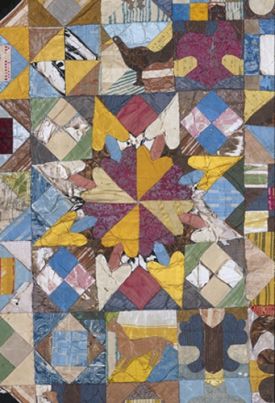The 1718 Silk Coverlet
Published: Friday, 12th June 2009 16:19 PM

The 1718 coverlet was bought by The Quilters' Guild at auction in September 2000. Until that time it had been in the possession of the Brown family of Aldbourne, Wiltshire, for many years. The coverlet is an outstanding historical piece, and the worked date of 1718 identifies it as one of the earliest known dated patchworks.
The coverlet measures approximately 169 x 185cm (66" x 73") and is made up of basic units of 11cm (4") square. The block containing the date also has the two initials "E" and "H" worked into it.
The coverlet is made from silk fabrics, apart from 6 pieces of wool velvet or plush, and is constructed in the technique known as 'piecing over papers', where the fabric is folded and tacked over a paper shape before being stitched together. The blocks have been stitched together with white linen thread. The tacking remains in place and unusually is worked through the back fold of the fabric and the papers only; no tacking can be seen on the front of the coverlet. The back of the coverlet is linen, pieced together in the form of a crazy patchwork of recycled pieces.
The fact that the papers have not been removed, even though it has a backing, has helped to preserve the coverlet. The coverlet was x-rayed by a special radiography machine in the hope that the papers would provide some information about the maker and her life at the time the quilt was made but sadly this did not happen and the papers are keeping their secrets. It was, however, discovered that some of the fabrics had originally had gold patterns on them, which have since vanished. Extensive genealogical research in to the family and the area where they lived has failed to identify the owners of the initials E and H and the maker of the coverlet remains unknown.
Almost all the fabrics are dress fabrics, the majority of which show signs of previous use. There are over 120 different fabric designs used and the oldest fabric has been identified as being from the 1640's.
There is a great variety in the block designs. Simple geometric designs are pieced alongside complex representational motifs including; hearts, a man and a woman, stylised flowers, tulips, a partridge, pheasant, deer, a cat with a bird in its mouth, dog, rabbit, swan, goose, butterfly, lion and a unicorn. The construction of each of these motif units is complex with even components such as beaks, legs and tails for the animals and stems and leaves for the flowers being worked as separate pieces over papers.
As the original coverlet is too fragile for display except in specialist museum conditions The Guild decided to make a replica to duplicate as far as possible the size, colour and fabrics of the original. The replica also used the same method of construction. Our expert 'replicators' were Guild members. Pauline Adams, who masterminded the construction of the replica coverlet, had great difficulty obtaining appropriate fabrics; skilled dyers provided some indigo dyed silks and Pauline painted some herself. Some fabrics had to be 'recreated' using modern computer technology. The result is a look-a-like, as-good-as-new coverlet that can now be displayed. Through exhibition of the replica, The Guild hopes that people around the world will appreciate the beauty and interest of this our most important historical item.1718 silk patchwork coverlet
As the earliest dated example of British patchwork the coverlet has a profound importance and relevance not only to patchwork and quilting but also the cultural and social history of the British Isles and beyond. The 1718 coverlet has been conserved and is now in a condition that will keep it safe for occasional display hopefully for many years to come. The cost of this important conservation has been met by the generosity of several grant-making bodies and we are most grateful for the financial contribution and their recognition of the immense historical value of this magnificent quilt.
 1718 Silk Converlet
1718 Silk Converlet
 Full size 1718 Silk Coverlet
Full size 1718 Silk Coverlet